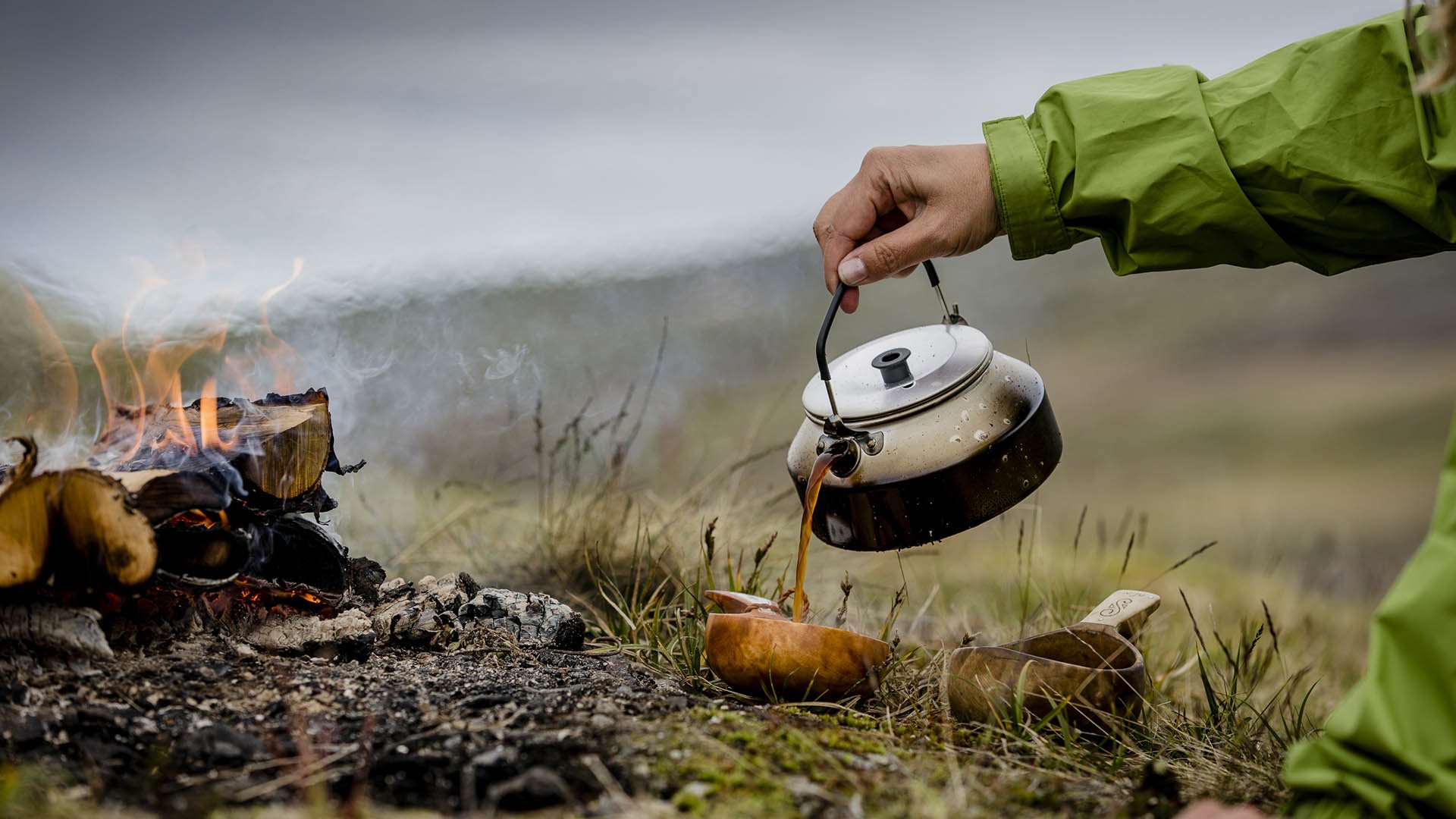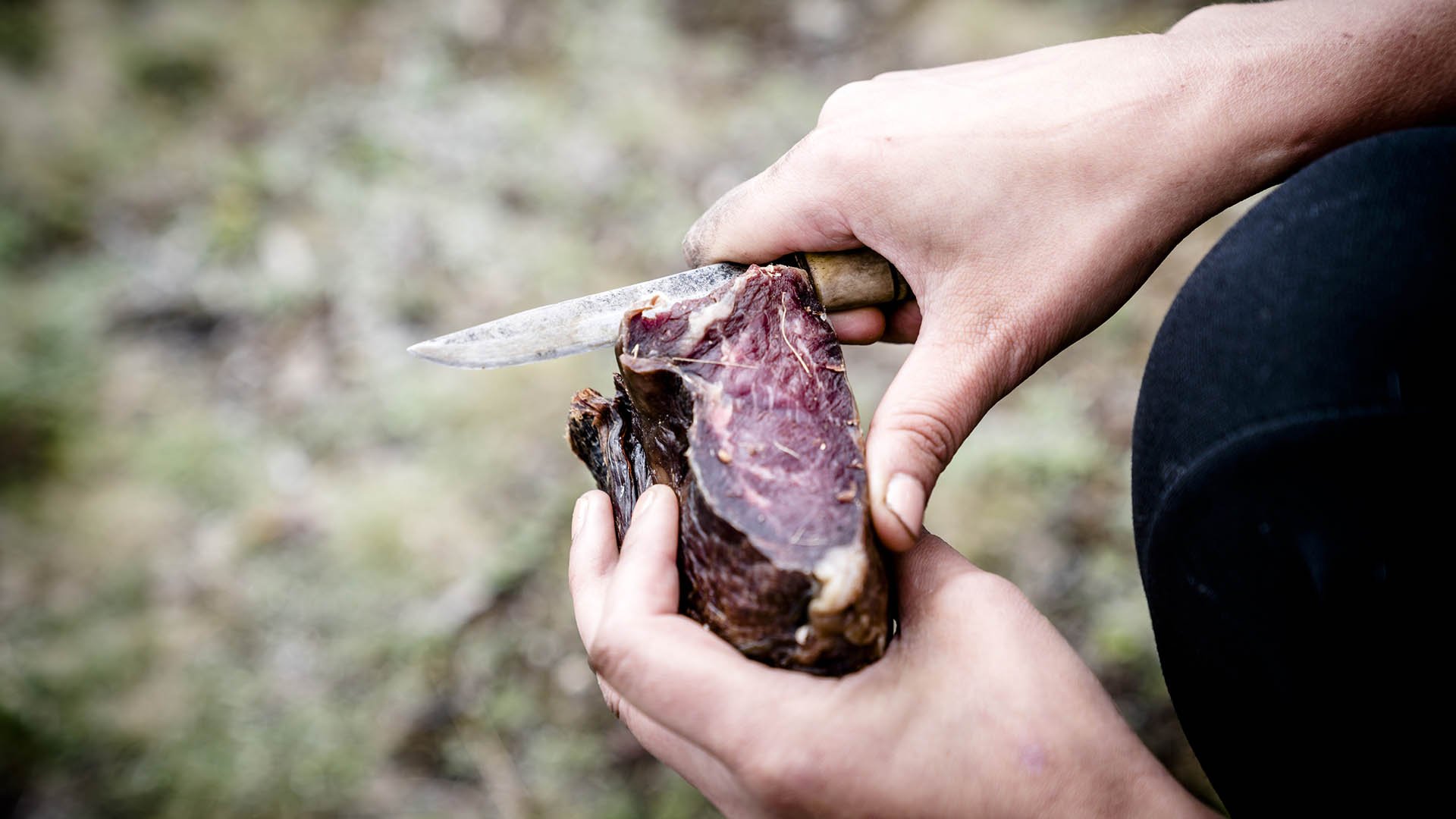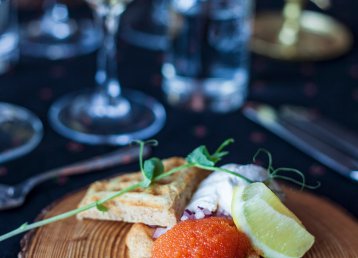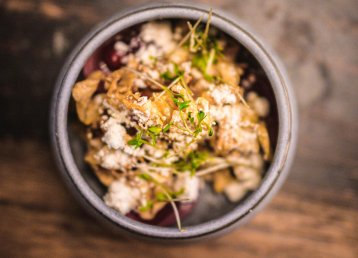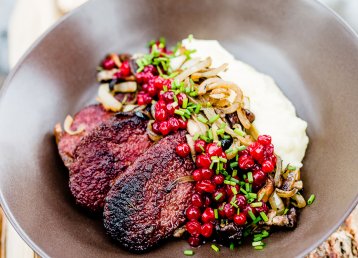Kaffeost
In Tornedalen, the coffee cheese is called kahvijuusto, and in Swedish, we call it kaffeost. It could be a fresh cheese that in many ways resembles the Italian mozzarella. But in northern Sweden and Finland coffee cheese often come in a baked form as well. (This is all coffee cheese you will buy at the supermarket). You could eat it as a dessert, warm with cloudberry jam. But more typical, and hence the name, you cut small pieces of the cheese and put them in a cup and pour your coffee on them. The cheese itself has a very neutral taste, but one distinct feature is the way it feels when you chew it. Kaffeost is something you just have to try.
IN THE COFFEE
It might be one of Swedish Lapland’s weirdest habits, our custom to put cheese and meat in the coffee. But it’s a very long tradition that we still cherish and just like Jonny Johansson says: It’s oh, so good.

Surströmming
Fermented herring is best served with potatoes, onion and sour cream in a "klämma". Photo: Magnus Skoglöf.
Surströmming
Let’s be honest; this failed recipe can only be loved by those who have grown up with it. A Baltic herring cured in just enough salt so it won’t rot, but ferment in its salty brine is a favourite among many.
A new Japanese study actually shows that surströmming, or fermented herring, has a stronger smell than similar dishes like Japanese kusaya and Korean hongeo-hoe. And the smell of the latter always described as reminiscent of an “outhouse”. But in the north, we have been eating surströmming since the 16th century. And the opening day of the season is always in the middle of August – and always makes for a party. The most popular way to eat surströmming is between two flatbreads, with potatoes, onion and sour cream. That often goes by the name “klämma”.
Gurpi
The Sámi word for packing or a package is guorpat. So when some Sámi food entrepreneurs didn’t really know what to call the new dish that they had made out of lightly smoked minced meat packed in a crepinette, they came up with the obvious name gurpi.
You can buy gurpi at several shops up north. The two ways to cook it is in a frying pan at home, or above an open fire. Or two: Just on a stick above the open campfire, like you would grill a sausage. Gurpi goes exceptionally well with the typical Sámi flatbread called gáhkku.
Also read
Sápmi slow food with Ingrid PiltoPalt
Our take on Europe’s favourite “knödel”, or the dumplings of Asia, is called: palt. But to tell the truth – the palt is a bit more rustic than any dumpling in the world.
There is a bunch of variations on how to make palt. But common recipes up north are that you do the dough out of grated potatoes, flour and some salt. A trick is, if you take the grated potato and press out as much liquid out as possible before you do the dough, you don’t need as much flour. (Some use a bit of barley flour instead of regular flour). Out of the dough, you form balls that you fill with fried brine pork before you let them boil for 45-60 minutes. Or skip filling the palt and serve the pork on the side. Palt is always best served with lingonberry jam, butter, and cold milk or lingonberry juice.
Kalix löjrom
Perhaps this is the signature dish of Swedish Lapland. At least at any fancy dinner party, most of the Nobel festivities included, Kalix löjrom is the go-to ingredients. Much like Champagne, Parma ham or Stilton cheese is the staple of something good and beautiful. But not necessarily together. But just like stilton, champagne, Parma ham and all the other signature foods that are named a Protected Designation of Origin Kalix löjrom have strong local importance. Too the culture and the kitchen. There are many ways to serve Kalix löjrom, with red onion and sour cream, on bread or a piece of potato is common. The left-over in the production, the actual fish, is perfect to salt in a brine and then broil on the grill or open fire.
Also read
The gold of the Bothnian BayKokkaffe
We boil our coffee preferably on an open fire but mostly on the stove. For that, you need coffee that has been grained a bit thicker than for your usual espresso or bistro. The grained coffee needs to take up water and get so heavy that they sink to the bottom of the pan, that’s why it’s not as fine-grained as espresso.
In the old days, the Sámi people, as well as the settlers, used to put salt in the coffee. They needed salt after a hard day’s work. But salt also takes away the bitter taste in coffee, that often occurs when you boil it in too warm water. Don’t put your grains into boiling water; perfect is 92–96 centigrades – if you don’t want to put salt in there.
Also read
Swedish fika – Arctic styleDopp-i-kopp
One of the unique dishes of Swedish Lapland is Dopp-i-kopp. It was made famous around Sweden by Werner Vögeli, a former chef at Operakällaren and the Swedish court. Dopp-i-kopp was his favourite dish in Sweden. If you translate the word Dopp-i-kopp, it pretty much explains what it’s all about ”Dip in a cup”. You put butter, salt, some finely sliced onion and dill in a bowl or a cup, and then you melt the butter by pouring hot water – the water you have used for boiling potatoes – in the cup. You eat by dipping the fresh potatoes in the broth you created. Best is, of course, small summer potatoes and in Tornedalen, you often eat this together with fish that has been cured, smoked or broiled.
Torrkött
Dried meat, what is often called jerky, is of course also a staple food in the north. Basically depending on two reasons: drying the food would conserve it for a long time. And drying it would make it so much easier to bring it along for nomads and workers.
You cut your meat into thin slices and put them in a salt brine to get salty, before hanging it up in the late of winter (February–March). The meat would then “freeze-dry” during a time when the sunlight would grow from day to day, but still, you wouldn’t have any flies or bugs around your meat. Reindeer and moose are excellent meat for drying. All commercially sold dried meat also has to be a little smoked. But for your own use that isn’t necessary.

















